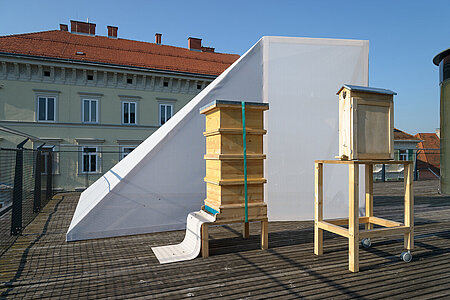The word Bien is a historically evolved term for the super-organism of the bee colony, which was formed by such individuals as Johannes Mehring, a pioneer of economic bee-keeping, and Rudolf Steiner, the founder of anthroposophy. Bien describes the functioning organism of a bee colony, which on account of those characteristics ascribed to it in the swarm such as diligence, cleanliness, orderliness and adaptation, has continually been drawn upon in the history of mankind as a metaphor and model for societies, though also as an image of the scary excessive-ego, of a superconscious global context.
The artist Sarah Bildstein connects the characteristic of adaptiveness to one of her previous works, Assimilationknick, 2014. The form of this work contributed to the design of the new environment created for the bees to live in on the Kunsthaus roof. The wooden construction, covered with a light fabric, has developed into a canvas with a crease, with the help of which the construction acquires stability in the first place. Adapted to the place where it is erected, the Bien is also active overnight and glows in a dynamic succession of colours at nightfall.
Der Bien serves as protection against the wind and sun for two beehives with a population of around 35,000 bees, of which approx. 8,000 bees will discover a new living space and source of food some 600-800 m in radius, namely the banks of the River Mur and the Schlossberg, over a period of seven months.
Sarah Bildstein sees living spaces as spaces for relationships that include and exclude, and repeatedly takes as a theme for her installations and picture objects questions concerning the ‘necessary’ demarcations between what is innate and what is other. The materials used are frequently ‘poor’ ones such as textiles, adhesive film or steel wool, which are used in manufacturing and production processes and to which she takes a pragmatic and personal approach.





















